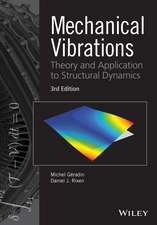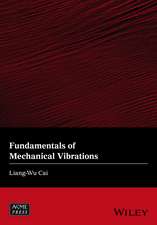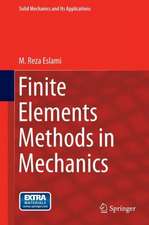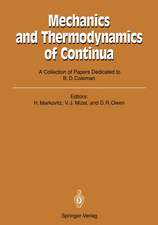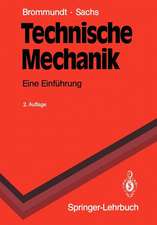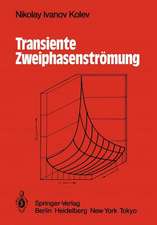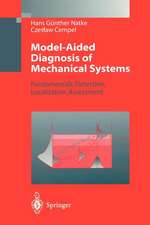Thermal Stresses -- Advanced Theory and Applications: Solid Mechanics and Its Applications, cartea 158
Autor Richard B. Hetnarski, M. Reza Eslamien Limba Engleză Paperback – 24 noi 2010
| Toate formatele și edițiile | Preț | Express |
|---|---|---|
| Paperback (1) | 807.84 lei 39-44 zile | |
| SPRINGER NETHERLANDS – 24 noi 2010 | 807.84 lei 39-44 zile | |
| Hardback (1) | 661.65 lei 6-8 săpt. | |
| SPRINGER NETHERLANDS – 23 dec 2008 | 661.65 lei 6-8 săpt. |
Din seria Solid Mechanics and Its Applications
- 20%
 Preț: 698.09 lei
Preț: 698.09 lei - 24%
 Preț: 800.14 lei
Preț: 800.14 lei - 15%
 Preț: 640.06 lei
Preț: 640.06 lei - 15%
 Preț: 653.14 lei
Preț: 653.14 lei - 18%
 Preț: 1124.92 lei
Preț: 1124.92 lei - 15%
 Preț: 643.84 lei
Preț: 643.84 lei - 18%
 Preț: 1119.38 lei
Preț: 1119.38 lei - 20%
 Preț: 573.17 lei
Preț: 573.17 lei - 18%
 Preț: 1607.92 lei
Preț: 1607.92 lei - 17%
 Preț: 393.72 lei
Preț: 393.72 lei - 17%
 Preț: 459.40 lei
Preț: 459.40 lei - 18%
 Preț: 959.98 lei
Preț: 959.98 lei - 18%
 Preț: 747.71 lei
Preț: 747.71 lei -
 Preț: 388.55 lei
Preț: 388.55 lei - 18%
 Preț: 787.15 lei
Preț: 787.15 lei -
 Preț: 406.25 lei
Preț: 406.25 lei - 15%
 Preț: 639.08 lei
Preț: 639.08 lei - 24%
 Preț: 784.82 lei
Preț: 784.82 lei - 15%
 Preț: 643.34 lei
Preț: 643.34 lei - 18%
 Preț: 958.07 lei
Preț: 958.07 lei - 18%
 Preț: 1228.15 lei
Preț: 1228.15 lei - 18%
 Preț: 734.27 lei
Preț: 734.27 lei - 18%
 Preț: 1233.06 lei
Preț: 1233.06 lei - 18%
 Preț: 1236.19 lei
Preț: 1236.19 lei - 18%
 Preț: 950.96 lei
Preț: 950.96 lei - 18%
 Preț: 906.48 lei
Preț: 906.48 lei - 18%
 Preț: 964.54 lei
Preț: 964.54 lei - 20%
 Preț: 995.75 lei
Preț: 995.75 lei - 18%
 Preț: 953.65 lei
Preț: 953.65 lei - 18%
 Preț: 1239.67 lei
Preț: 1239.67 lei - 18%
 Preț: 962.35 lei
Preț: 962.35 lei - 18%
 Preț: 964.54 lei
Preț: 964.54 lei - 18%
 Preț: 913.11 lei
Preț: 913.11 lei - 18%
 Preț: 1226.90 lei
Preț: 1226.90 lei - 18%
 Preț: 945.47 lei
Preț: 945.47 lei
Preț: 807.84 lei
Preț vechi: 1062.95 lei
-24% Nou
Puncte Express: 1212
Preț estimativ în valută:
154.60€ • 161.20$ • 128.49£
154.60€ • 161.20$ • 128.49£
Carte tipărită la comandă
Livrare economică 17-22 martie
Preluare comenzi: 021 569.72.76
Specificații
ISBN-13: 9789048180981
ISBN-10: 9048180988
Pagini: 592
Dimensiuni: 155 x 235 x 31 mm
Greutate: 0.82 kg
Ediția:Softcover reprint of hardcover 1st ed. 2009
Editura: SPRINGER NETHERLANDS
Colecția Springer
Seria Solid Mechanics and Its Applications
Locul publicării:Dordrecht, Netherlands
ISBN-10: 9048180988
Pagini: 592
Dimensiuni: 155 x 235 x 31 mm
Greutate: 0.82 kg
Ediția:Softcover reprint of hardcover 1st ed. 2009
Editura: SPRINGER NETHERLANDS
Colecția Springer
Seria Solid Mechanics and Its Applications
Locul publicării:Dordrecht, Netherlands
Public țintă
Professional/practitionerDescriere
The
authors
are
pleased
to
present
Thermal
Stresses
–
Advanced
Theory
and
Applications.
This
book
will
serve
a
wide
range
of
readers,
in
particular,
gr-
uate
students,
PhD
candidates,
professors,
scientists,
researchers
in
various
industrial
and
government
institutes,
and
engineers.
Thus,
the
book
should
be
considered
not
only
as
a
graduate
textbook,
but
also
as
a
reference
handbook
to
those
working
or
interested
in
areas
of
Applied
Mathematics,
Continuum
Mechanics,
Stress
Analysis,
and
Mechanical
Design.
In
addition,
the
book
p-
vides
extensive
coverage
of
great
many
theoretical
problems
and
numerous
references
to
the
literature.
The
?eld
of
Thermal
Stresses
lies
at
the
crossroads
of
Stress
Analysis,
T-
ory
of
Elasticity,
Thermodynamics,
Heat
Conduction
Theory,
and
advanced
methods
of
Applied
Mathematics.
Each
of
these
areas
is
covered
to
the
extend
it
is
necessary.
Therefore,
the
book
is
self-contained,
so
that
the
reader
should
not
need
to
consult
other
sources
while
studying
the
topic.
The
book
starts
from
basic
concepts
and
principles,
and
these
are
developed
to
more
advanced
levels
as
the
text
progresses.
Nevertheless,
some
basic
preparation
on
the
part
of
the
reader
in
Classical
Mechanics,
Stress
Analysis,
and
Mathematics,
-
cluding
Vector
and
Cartesian
Tensor
Analysis
is
expected.
While
selecting
material
for
the
book,
the
authors
made
every
e?ort
to
present
both
classical
topics
and
methods,
and
modern,
or
more
recent,
dev-
opments
in
the
?eld.
The
book
comprises
ten
chapters.
Cuprins
1
Basic
Laws
of
Thermoelasticity;
1
Introduction;
2
Stresses
and
Tractions;
3
Equations
of
Motion
;
4
Coordinate
Transformation.
Principal
Axes;
5
Principal
Stresses
and
Stress
Invariants;
6
Displacement
and
Strain
Tensor;
7
Compatibility
Equations.
Simply
Connected
Region;
8
Compatibility
Conditions.
Multiply
Connected
Regions;
9
Constitutive
Laws
of
Linear
Thermoelasticity;
10
Displacement
Formulation
of
Thermoelasticity;
11
Stress
Formulation
of
Thermoelasticity;
12
Two-Dimensional
Thermoelasticity;
13
Michell
conditions;
2
Thermodynamics
of
Elastic
Continuum;
1
Introduction;
2
Thermodynamics
Definitions;
3
First
Law
of
Thermodynamics
;
4
Second
Law
of
Thermodynamics;
5
Variational
Formulation
of
Thermodynamics;
6
Thermodynamics
of
Elastic
Continuum;
7
General
Theory
of
Thermoelasticity
;
8
Free
Energy
Function
of
Hookean
Materials;
9
Fourier's
Law
and
Heat
Conduction
Equation
;
10
Generalized
Thermoelasticity.
Second
Sound;
11
Thermoelasticity
without
Energy
Dissipation;
12
Uniqueness
Theorem;
13
Variational
Principle
of
Thermoelasticity
;
14
Reciprocity
Theorem;
15
Initial
and
Boundary
Conditions;
3
Basic
Problems
of
Thermoelasticity;
1
Introduction;
2
Temperature
Distribution
for
Zero
Thermal
Stress;
3
Analogy
of
Thermal
Gradient
with
Body
Forces
;
4
General
Solution
of
Thermoelastic
Problems;
5
General
Solution
in
Cylindrical
Coordinates;
6
Solution
of
Two-Dimensional
Navier
Equations;7
Solution
of
Problems
in
Spherical
Coordinates;
4
Heat
Conduction
Problems;
1
Introduction;
2
Problems
in
Rectangular
Cartesian
Coordinates;
2.1
Steady
State
One-Dimensional
Problems;
2.2
Steady
Two-Dimensional
Problems.
Separation
of
Variables;
2.3
Fourier
Series;
2.4
Double
Fourier
Series;
2.5
Bessel
Functions
and
Fourier-Bessel
series;
2.6
Nonhomogeneous
Differential
Equations
and
Boundary
Condition;
2.7
Lumped
Formulation;
2.8
Steady
State
Three-Dimensional
Problems;
2.9.Transient
Problems;
3
Problems
in
Cylindrical
coordinates;
3.1
Steady-State
One-Dimensional
Problems
(Radial
Flow);
3.2.
Steady
-State
Two-Dimensional
Problems
3.3
Steady-State
Three-Dimensional
Problems;
3.4
Transient
Problems;
4
Problems
in
Spherical
Coordinates;
4.1
Steady-State
One-Dimensional
Problems;
4.2
Steady-State
Two-
and
Three-Dimensional
Problems;
4.3
Transient
Problems;
5
Thermal
Stresses
in
Beams;
1
Introduction;
2
Elementary
Theory
of
Thermal
Stresses
in
Beams;
3
Deflection
Equation
of
Beams;
4
Boundary
Conditions;
5
Shear
Stress
in
a
Beam;
6
Beams
of
Rectangular
Cross
Section;
7
Transient
Thermal
Stresses
in
Rectangular
Beams;
8
.
Beam
with
Internal
Heat
Generation;
9
Bimetallic
Beam;
10
Functionally
Graded
Beams;
11
Transient
Thermal
Stresses
in
Functionally
Graded
Beams;
12
Thermal
Stresses
in
Thin
Curved
Beams
and
Rings;
13
Deflection
of
Thin
Curved
Beams
and
Rings;
6
Disks,
Cylinders,
and
Spheres;1
Introduction;
2
.
Cylinders
with
Radial
Temperature
Variation;
3
Thermal
Stresses
in
Disks;
4
Thick
Spheres
;
5
Thermal
Stresses
in
a
Rotating
Disk;
6
Non-Axisymmetrically
Heated
cylinders;
7
Method
of
Complex
Variables;
8
Functionally
Graded
Thick
Cylinders;
9
Axisymmetric
Thermal
Stresses
in
FGM
Cylinders;
10.Transient
Thermal
Stresses
in
Thick
Spheres;
11
Functionality
Graded
Spheres;
7
Thermal
Expansion
in
Piping
Systems;1
Introduction
;
2
Definition
of
the
Elastic
Center;
3
.
Piping
Systems
in
Two
Dimensions
;
4
Piping
Systems
in
Three-dimensions;
5
Pipelines
with
Large
Radius
Elbows;
8
Coupled
and
Generalized
Thermoelasticity;1
Introduction;
2
Governing
Equations
of
Coupled
Thermoelasticity;
3
Coupled
Thermoelasticity
for
Infinite
Space;
4
Variable
Heat
Source;
5
One-Dimensional
Coupled
Problem;
6
Propagation
of
Discontinuities;
7
Half-Space
Subjected
to
a
Harmonic
Temperature;
8
Coupled
Thermoelasticity
of
Thick
Cylinders;
9
Green-Naghdi
Model
of
a
Layer;
10
Generalized
Thermoelasticity
of
Layers;
11
Generalized
Thermoelasticity
of
Spheres
and
Cylinders;
Textul de pe ultima copertă
This
book
is
intended
as
an
advanced
modern
textbook
and
reference
handbook
on
the
topic
of
thermal
stresses.
It
should
serve
a
wide
range
of
readers,
in
particular,
graduate
and
postgraduate
students,
scientists,
researchers
in
various
industrial
and
government
institutes,
and
engineers
working
in
mechanical,
civil,
and aerospace
engineering.
This volume covers diverse areas of applied mathematics, continuum mechanics, stress analysis, and mechanical design. This work treats a number of topics not presented in other books on thermal stresses, for example: theory of coupled and generalized thermoelasticity, finite and boundary element method in generalized thermoelasticity, thermal stresses in functionally graded structures, and thermal expansions of piping systems.
As the field of thermal stresses lies at the crossroads of stress analysis, theory of elasticity, heat conduction, and advanced methods of applied mathematics, all these subjects are dealt with in the book to the extent they are necessary. Thus, the book is self-contained, so that the reader should not need to consult other sources while studying the topic. The book starts from basic concepts and principles, and these are developed to more advanced levels as the text progresses. Nevertheless, some basic knowledge on the part of the reader is expected in classical mechanics, stress analysis, and mathematics, including vector and cartesian tensor analysis.
This volume covers diverse areas of applied mathematics, continuum mechanics, stress analysis, and mechanical design. This work treats a number of topics not presented in other books on thermal stresses, for example: theory of coupled and generalized thermoelasticity, finite and boundary element method in generalized thermoelasticity, thermal stresses in functionally graded structures, and thermal expansions of piping systems.
As the field of thermal stresses lies at the crossroads of stress analysis, theory of elasticity, heat conduction, and advanced methods of applied mathematics, all these subjects are dealt with in the book to the extent they are necessary. Thus, the book is self-contained, so that the reader should not need to consult other sources while studying the topic. The book starts from basic concepts and principles, and these are developed to more advanced levels as the text progresses. Nevertheless, some basic knowledge on the part of the reader is expected in classical mechanics, stress analysis, and mathematics, including vector and cartesian tensor analysis.
Caracteristici
The
first
and
only
book
on
the
subject
with
so
many
engineering
applications
besides
the
theory
Covers not only linear problems of Thermal Stresses, as earlier books do, but nonlinear problems, e.g., contains the whole chapter on Creep Analysis due to Thermal Stresses; this is absolutely unique
Is a textbook on graduate level (although it starts with basic concepts and principles), with many solved problems in the text and many problems at the end of chapters
Covers topics of modern theories (now of substantial interest), like Coupled Thermoelasticity and Generalized Thermoelasticty, and Functionally Graded Structures
Covers Finite Element Method as applied to Thermal Stresses, as well as Boundary Element Method
Covers not only linear problems of Thermal Stresses, as earlier books do, but nonlinear problems, e.g., contains the whole chapter on Creep Analysis due to Thermal Stresses; this is absolutely unique
Is a textbook on graduate level (although it starts with basic concepts and principles), with many solved problems in the text and many problems at the end of chapters
Covers topics of modern theories (now of substantial interest), like Coupled Thermoelasticity and Generalized Thermoelasticty, and Functionally Graded Structures
Covers Finite Element Method as applied to Thermal Stresses, as well as Boundary Element Method




